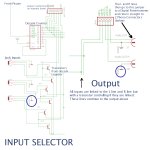George Sephton
Senior Member
Hi all,
I've had a PCB fabricated and one of the features on the board is an audio input selector. This works with a PICAXE connected to a decade counter which counts to the correct input. Each input (a 3.5mm audio connector) has L, R and GND which comes out and joins to 3 lines, L, R and GND, but with a transistor between the Jack and the line, except for GND which are all linked together. So when each number on the decade counter is selected, 2 transistors for the appropriate input open allowing the audio onto the line. This line then goes to a jumper (to a seperate digital potentiometer, not connected for my problem) and returns where it goes to 2 phono connectors, I have attached the schematic with annotations to explain this.
Now when I select and input, the sound that returns is always a loud hum, often with a slight rhythm of the song on my ipod in the background, or sometimes returns a sound like a galloping horse.
Please help me with this problem, it doesn't make any sense. I have used a little speaker with wires attached to see if audio can be heard throughout the pcb, I know for a fact the audio is coming in fine from the socket.
I have just looked at the transistors (SOT-23 SMD) and the sound works on the collector and GND but the emitter and GND emits a hum, so I'm assuming there must be something wrong with these?
Any help would be appreciated so much,
George S.
I've had a PCB fabricated and one of the features on the board is an audio input selector. This works with a PICAXE connected to a decade counter which counts to the correct input. Each input (a 3.5mm audio connector) has L, R and GND which comes out and joins to 3 lines, L, R and GND, but with a transistor between the Jack and the line, except for GND which are all linked together. So when each number on the decade counter is selected, 2 transistors for the appropriate input open allowing the audio onto the line. This line then goes to a jumper (to a seperate digital potentiometer, not connected for my problem) and returns where it goes to 2 phono connectors, I have attached the schematic with annotations to explain this.
Now when I select and input, the sound that returns is always a loud hum, often with a slight rhythm of the song on my ipod in the background, or sometimes returns a sound like a galloping horse.
Please help me with this problem, it doesn't make any sense. I have used a little speaker with wires attached to see if audio can be heard throughout the pcb, I know for a fact the audio is coming in fine from the socket.
I have just looked at the transistors (SOT-23 SMD) and the sound works on the collector and GND but the emitter and GND emits a hum, so I'm assuming there must be something wrong with these?
Any help would be appreciated so much,
George S.
Attachments
-
185.1 KB Views: 64
Last edited:

